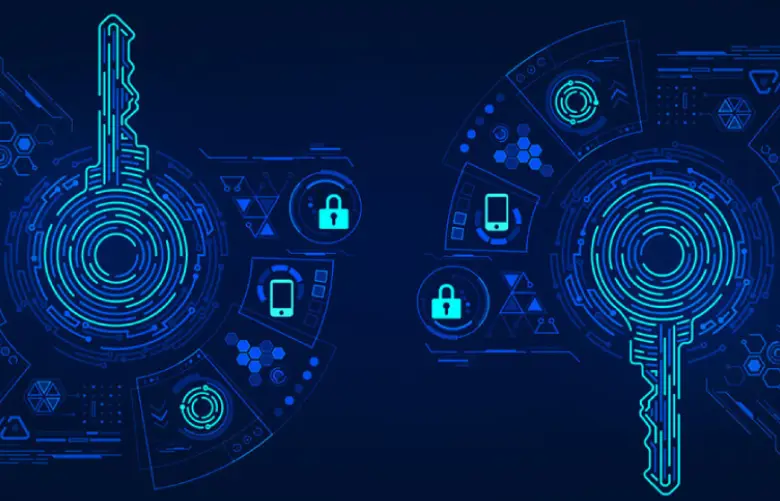A symmetric key is a form of cryptographic key utilized in symmetric-key cryptography, functioning as a singular confidential key for data encryption and decryption.
The symmetric key cryptography method employs an identical key throughout the encryption and decryption procedures, simplifying the process and enhancing efficiency. Nevertheless, due to the key’s dual role, ensuring secure distribution and effective Management among communicating parties becomes an essential and challenging aspect.
What is Symmetric Encryption Used For?
Symmetric key cryptography is used for secure data transmission and storage. It involves using the same key for both encryption and decryption. This method ensures confidentiality, integrity, and authenticity of information. Common applications include secure communication over networks, protecting sensitive files, and ensuring data privacy in various digital systems.

POSTGRADUATE PROGRAM IN
Multi Cloud Architecture & DevOps
Master cloud architecture, DevOps practices, and automation to build scalable, resilient systems.
Key Management for symmetric encryption – what we need to consider
Effective Management of keys is of utmost importance in symmetric encryption, encompassing the secure creation, distribution, retention, rotation, and eventual disposal of encryption keys. When dealing with extensive systems, it’s essential to address key Management meticulously.
This entails considerations such as large-scale system requirements and an exploration of various types of symmetric key cryptography.

Explore our blog on Demystifying the Super Key Concept in DBMS now!
Key Management Considerations
Key Generation: Use a secure random number generator to create strong encryption keys with enough entropy to resist attacks.
Key Distribution: Securely share keys between authorized parties. Avoid transmitting keys in plaintext; use secure key exchange protocols like Diffie-Hellman.
Key Storage: Protect keys from unauthorized access. Use hardware security modules (HSMs) or secure key vaults to store keys securely.
Key Usage Policies: Define policies regarding who can access and use keys, and under what conditions. Implement proper access controls and permissions.
Key Rotation: Regularly change keys to minimize the impact of a compromised key. This requires planning for seamless transitions to new keys.
Key Deletion: Properly dispose of keys that are no longer needed. Ensure that deleted keys cannot be recovered.
Key Escrow: In some cases, especially for data recovery purposes, you might need to escrow a copy of the keys securely.
Key Auditing and Monitoring: Monitor key usage and access patterns to detect anomalies or potential breaches.
Key Backup and Recovery: Implement processes to back up keys and recover them in case of hardware failures or other emergencies.
Key Lifecycle Management: Implement a well-defined key lifecycle that covers generation, distribution, usage, rotation, and retirement.
Attribution Data
Digital Content: In digital media, attribution data could include information about the creator of an image, video, or audio file. This data helps give credit to the original creator and can be important for respecting copyright and intellectual property rights.
Cybersecurity and Digital Forensics: Attribution data might be crucial in investigating cyberattacks or online incidents. It involves identifying the origin of malicious activities or hacking attempts to hold responsible parties accountable.
Open Source Software: In open-source projects, attribution data ensures that contributors receive proper credit for their work. Many open-source licenses require that attribution is maintained when the code is used or distributed.
Academic and Research Work: Attribution data is essential in academic and research contexts to properly credit the authors of studies, papers, and research findings. It helps in building upon existing knowledge and acknowledging scholarly contributions.
Key Management at large scale
Managing keys at a large scale can be more complex due to increased volumes of keys and the potential for more points of vulnerability. Here are some additional considerations for symmetric key cryptography:
Automation: Implement automated key management processes to handle the scale efficiently and reduce the risk of human errors.
Centralization: Consider centralizing key Management to ensure consistent policies and procedures across the organization.
Hierarchical Key Management: Use hierarchical approaches to manage keys, where different levels of keys are used for different purposes, aiding in security and Management.
Key Partitioning: Partition keys are based on different factors, such as departments, projects, or geographical regions, to limit exposure in case of a breach.
Scaling Key Storage: Ensure the chosen solution can handle the increased load and redundancy requirements.
Symmetric-key encryption types
Symmetric key cryptography uses the same key for both encryption and decryption. There are two main types:
Block Ciphers encrypt data in fixed-size blocks (e.g., 128 bits) using algorithms like AES (Advanced Encryption Standard).

Stream Ciphers encrypt data continuously, often one bit or byte at a time. They are efficient for real-time communication and are used in various encryption protocols.
Conclusion
Symmetric key cryptography stands as a foundational pillar in the realm of information security and secure communication. Its efficiency in encrypting and decrypting data through the use of a single shared key cannot be overlooked.
While symmetric key cryptography offers speed and computational efficiency, it may not be ideal for all scenarios, particularly regarding key distribution and the need for secure communication across multiple parties.
With a certification in Artificial Intelligence and Machine Learning at Hero Vired, take your automation and machine learning knowledge to greater heights. Learn about the best deep learning concepts and technologies now!
What are common use cases of symmetric encryption?
- Data Confidentiality: Protecting sensitive information during transmission or storage.
- Secure Communication: Securing messages, emails, and instant messaging ensures that only authorized parties can read them.
- Data Storage: Encrypting files and databases to prevent unauthorized access.
- VPN and TLS: Establishing secure connections over networks.
- Authentication: Encrypting authentication tokens to prevent tampering.
Is symmetric encryption suitable for encrypting sensitive files?
How often should symmetric keys be rotated?
What challenges arise in key Management at a large scale?
- Key Distribution: Securely distributing keys to authorized parties without exposing them to unauthorized individuals.
- Key Storage: Safely storing keys to prevent theft or unauthorized access.
- Key Rotation: Coordinating and managing the regular rotation of keys without disrupting operations.
- Key Revocation: Handling compromised or lost keys and ensuring they are no longer used for encryption.
- Auditability: Tracking key usage, changes, and access for compliance and security monitoring.
What are some common symmetric key cryptography algorithms?
- AES (Advanced Encryption Standard): Widely adopted for efficiency and security. It comes in different key sizes, like AES-128, AES-192, and AES-256.
- DES (Data Encryption Standard): An older algorithm largely replaced due to security concerns but still has historical significance.
- 3DES (Triple Data Encryption Standard): A more secure variant of DES is achieved by applying DES three times with different keys.
- Blowfish: A flexible algorithm suitable for various applications.
- RC4: A stream cipher is often used in older protocols, but it's now considered weak and not recommended.
Updated on July 4, 2024
